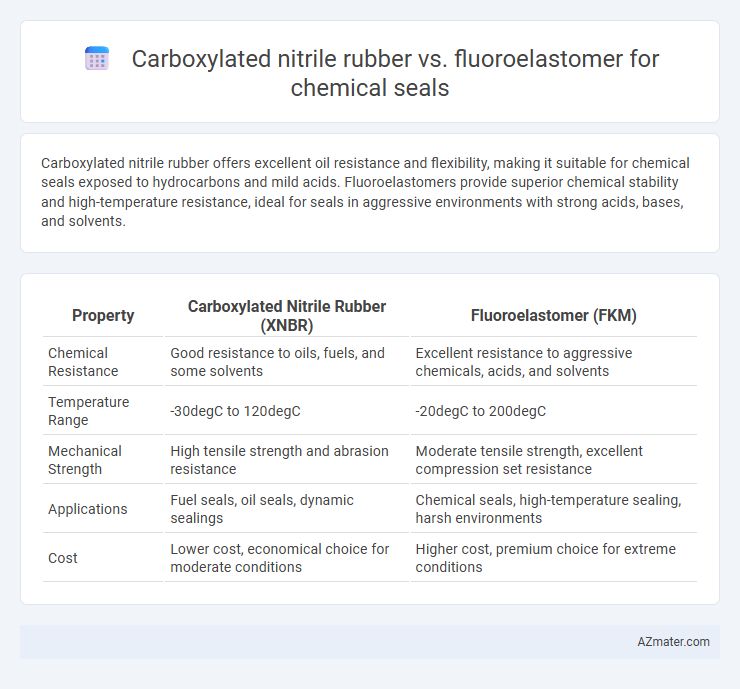Carboxylated nitrile rubber offers excellent oil resistance and flexibility, making it suitable for chemical seals exposed to hydrocarbons and mild acids. Fluoroelastomers provide superior chemical stability and high-temperature resistance, ideal for seals in aggressive environments with strong acids, bases, and solvents.
Table of Comparison
| Property | Carboxylated Nitrile Rubber (XNBR) | Fluoroelastomer (FKM) |
|---|---|---|
| Chemical Resistance | Good resistance to oils, fuels, and some solvents | Excellent resistance to aggressive chemicals, acids, and solvents |
| Temperature Range | -30degC to 120degC | -20degC to 200degC |
| Mechanical Strength | High tensile strength and abrasion resistance | Moderate tensile strength, excellent compression set resistance |
| Applications | Fuel seals, oil seals, dynamic sealings | Chemical seals, high-temperature sealing, harsh environments |
| Cost | Lower cost, economical choice for moderate conditions | Higher cost, premium choice for extreme conditions |
Introduction to Chemical Seal Materials
Carboxylated nitrile rubber (XNBR) and fluoroelastomers (FKM) are key materials widely used in chemical seal applications due to their distinct chemical resistance and mechanical properties. XNBR offers excellent abrasion resistance and good performance in petroleum-based fluids, making it suitable for seals exposed to oils and fuels. FKM provides superior resistance to a broad spectrum of harsh chemicals, high temperatures, and oxidative environments, making it ideal for sealing applications in aggressive chemical processing industries.
Overview of Carboxylated Nitrile Rubber (XNBR)
Carboxylated nitrile rubber (XNBR) offers enhanced abrasion resistance and improved mechanical properties compared to standard nitrile rubber, making it highly effective for chemical seals exposed to harsh environments. Its molecular structure includes carboxyl groups, providing superior oil, fuel, and chemical resistance essential for maintaining seal integrity under aggressive chemical exposure. XNBR is particularly valued in industries requiring strong adhesion and durability, such as automotive and aerospace, where reliable chemical sealing performance is critical.
Key Properties of Fluoroelastomer (FKM)
Fluoroelastomer (FKM) exhibits superior chemical resistance, especially against fuels, oils, acids, and solvents, making it ideal for chemical seal applications. It maintains excellent thermal stability and mechanical strength over a wide temperature range from -26degC to 204degC, outperforming carboxylated nitrile rubber in harsh environments. FKM also provides outstanding resistance to compression set and ozone aging, ensuring long-lasting durability in aggressive chemical exposure.
Chemical Resistance Comparison: XNBR vs FKM
Carboxylated nitrile rubber (XNBR) offers excellent resistance to abrasion and moderate chemical resistance, making it suitable for seals exposed to hydrocarbons, oils, and some acids, but it generally degrades faster when exposed to strong acids and solvents. Fluoroelastomer (FKM) provides superior chemical resistance across a wider range of aggressive chemicals, including fuels, acids, alkalis, and solvents, maintaining integrity under high temperature and harsh environments. For chemical seals requiring durability in highly aggressive chemicals or extreme conditions, FKM outperforms XNBR due to its enhanced molecular structure and cross-linking capabilities.
Temperature Stability: Carboxylated Nitrile Rubber vs Fluoroelastomer
Carboxylated nitrile rubber (XNBR) offers moderate temperature stability, typically functioning effectively within a range of -40degC to 120degC, making it suitable for standard chemical seal applications. In contrast, fluoroelastomers (FKM) exhibit superior temperature resistance, maintaining structural integrity and performance in environments ranging from -26degC up to 204degC or higher, ideal for high-heat chemical sealing. The enhanced thermal stability of fluoroelastomers allows for prolonged exposure to aggressive chemicals and elevated temperatures without significant degradation, outperforming carboxylated nitrile rubber in demanding industrial conditions.
Mechanical Strength and Compression Set
Carboxylated nitrile rubber (XNBR) exhibits superior mechanical strength compared to fluoroelastomers, making it ideal for applications requiring high tensile and tear resistance in chemical seals. XNBR typically demonstrates excellent compression set resistance, maintaining seal integrity under continuous stress and deformation. Fluoroelastomers, while offering exceptional chemical and heat resistance, generally show higher compression set values and lower mechanical strength, which can compromise long-term sealing performance in dynamic environments.
Compatibility with Industrial Chemicals
Carboxylated nitrile rubber (XNBR) offers excellent resistance to oils, fuels, and alkalis, making it suitable for seals exposed to petroleum-based chemicals and mild acids. Fluoroelastomers (FKM) provide superior chemical compatibility with aggressive solvents, high-temperature hydrocarbons, and strong acids, excelling in harsh industrial environments. Industrial applications requiring seals for a wide range of aggressive chemicals benefit from fluoroelastomer's enhanced durability and chemical inertness compared to carboxylated nitrile rubber.
Cost Analysis: XNBR vs FKM for Seals
Carboxylated nitrile rubber (XNBR) offers a cost-effective solution for chemical seals, with lower material and processing expenses compared to fluoroelastomers (FKM). While FKM provides superior chemical resistance and temperature stability, its higher price point makes XNBR more attractive for applications with moderate chemical exposure and budget constraints. Cost analysis reveals XNBR seals reduce overall expenditures by approximately 30-50%, balancing performance and affordability in chemical sealing applications.
Typical Applications in Chemical Environments
Carboxylated nitrile rubber (XNBR) excels in chemical seals exposed to fuels, oils, and hydrocarbons, commonly used in automotive fuel systems, oil drilling equipment, and industrial machinery seals due to its superior abrasion resistance and fuel compatibility. Fluoroelastomers (FKM) demonstrate exceptional chemical resistance to aggressive solvents, acids, and high-temperature environments, making them ideal for seals in chemical processing plants, aerospace fuel systems, and pharmaceutical manufacturing. The choice between XNBR and FKM depends on the specific chemical exposure and temperature requirements, with FKM preferred for harsher, more corrosive environments.
Choosing the Right Material for Chemical Seals
Carboxylated nitrile rubber (XNBR) offers excellent resistance to oils, fuels, and some solvents, making it ideal for chemical seals exposed to hydrocarbons with moderate temperature ranges up to 120degC. Fluoroelastomers (FKM) outperform XNBR in aggressive chemical environments, providing superior thermal stability up to 200degC and exceptional resistance to a wide variety of acids, alkalis, and hydrocarbons. Selecting the right material depends on the specific chemical exposure, temperature requirements, and mechanical properties, with fluoroelastomers preferred for high-performance seals in harsh chemical applications.

Infographic: Carboxylated nitrile rubber vs Fluoroelastomer for Chemical seal
 azmater.com
azmater.com